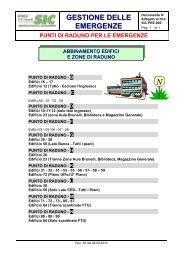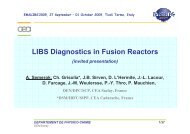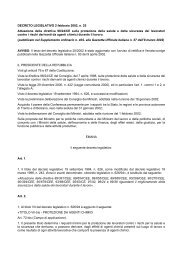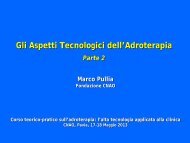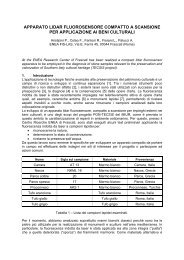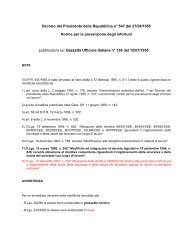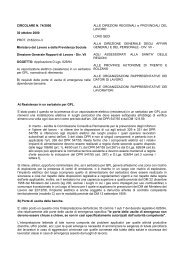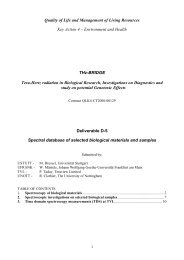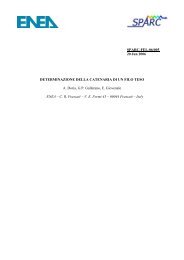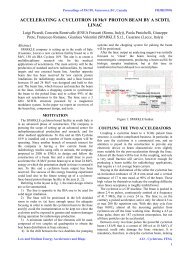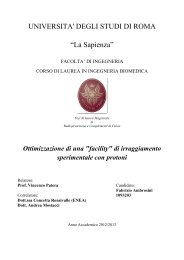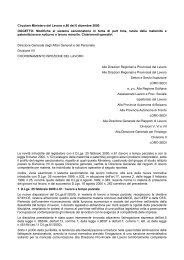Theory, Design and Tests on a Prototype Module of a Compact ...
Theory, Design and Tests on a Prototype Module of a Compact ...
Theory, Design and Tests on a Prototype Module of a Compact ...
Create successful ePaper yourself
Turn your PDF publications into a flip-book with our unique Google optimized e-Paper software.
obtains<br />
4. THE PERTURBED AXIAL FIELD 61<br />
Ii(ε l p, ε R p ) = (−1) N−i+1<br />
2 {cos [(N − i + 1)∆x]<br />
+ [sin [(N − i)∆x] − tan (∆x) cos [(N − i)∆x]]<br />
− tan (∆x)<br />
−<br />
N<br />
q=i<br />
N<br />
ε + q (−1) (i−q) cos [(2q − N − i)∆x]<br />
q=i<br />
ε − q (−1) (i−q) sin [(2q − N − i)∆x]<br />
<br />
N<br />
q=i<br />
ε + q<br />
(4.61)<br />
By noting that εp is a small quantity, we can exp<str<strong>on</strong>g>and</str<strong>on</strong>g> the trig<strong>on</strong>ometric<br />
functi<strong>on</strong>s around zero, leading to the following expressi<strong>on</strong> <strong>of</strong> Ii<br />
Ii(ε1, . . . , εN) = (−1) N−i+1<br />
⎧<br />
<br />
⎨<br />
N<br />
(N − i + 1)2<br />
2 1 − ε<br />
⎩ ∗ 2 p +<br />
+<br />
−<br />
N<br />
N<br />
ε<br />
p=1<br />
∗ p ε<br />
q=i<br />
+ q<br />
N<br />
N<br />
ε<br />
p=1<br />
∗ p ε<br />
q=i<br />
− q<br />
N 2<br />
p=1<br />
(i−q)<br />
N − i + 1 − (−1)<br />
N<br />
<br />
2q − N − i<br />
<br />
N<br />
(4.62)<br />
for i = 2s + 1 with s = 0, . . . , N<br />
− 1<br />
2<br />
<str<strong>on</strong>g>and</str<strong>on</strong>g> we note that the first is the imperturbed term, the sec<strong>on</strong>d term<br />
is independent <strong>of</strong> the errors positi<strong>on</strong>s <str<strong>on</strong>g>and</str<strong>on</strong>g> the last two are dependent,<br />
like for the perturbed res<strong>on</strong>ant frequency.<br />
It is worth noting that the cells current is stati<strong>on</strong>ary respect to the<br />
perturbati<strong>on</strong>s, because it depends <strong>on</strong> the square <strong>of</strong> ε L,R<br />
p .<br />
In the following the term (−1) N−i+1<br />
2 is c<strong>on</strong>sidered equal to 1, because<br />
it represents the phase relati<strong>on</strong> between accelerating cavities. In fact,<br />
at a certain time, the electric field E(t) in two adjacent accelerating<br />
cavities has a phase difference equal to π, but we are interested to the<br />
field experienced from the particles <str<strong>on</strong>g>and</str<strong>on</strong>g> they see always a positive field,<br />
<str<strong>on</strong>g>and</str<strong>on</strong>g> therefore we c<strong>on</strong>sider (−1) N−i+1<br />
2 = 1.<br />
In order to obtain Vci, it is sufficient to multiply the previous currents<br />
by the capacitive impedance <strong>of</strong> the cavities.<br />
If we come back to the case without errors, the structure we c<strong>on</strong>sider<br />
is symmetric <str<strong>on</strong>g>and</str<strong>on</strong>g> terminated <strong>on</strong> two half cavities, <str<strong>on</strong>g>and</str<strong>on</strong>g> therefore in the<br />
equivalent model, the circuits i = 1 <str<strong>on</strong>g>and</str<strong>on</strong>g> i = N + 1 have a double<br />
capacitance <str<strong>on</strong>g>and</str<strong>on</strong>g> an half inductance. The field in the cavities can be<br />
represented through a bar-plot as in figure 4.4, where the height <strong>of</strong>



